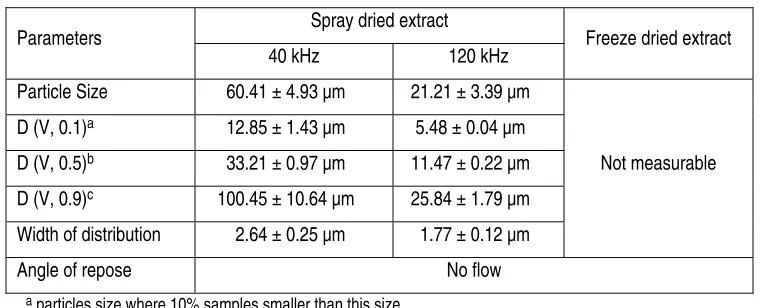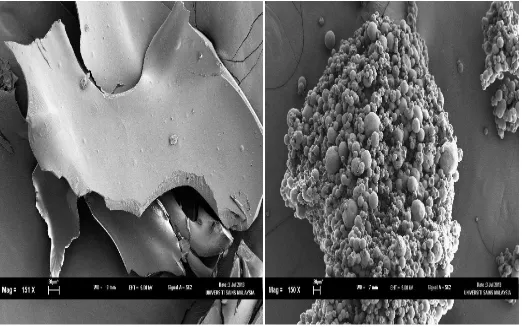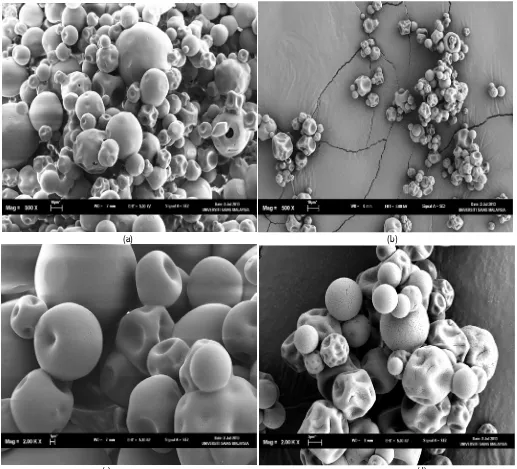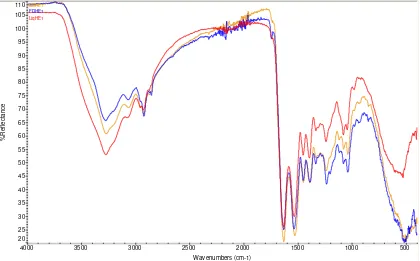International Journal of Drug Delivery 6 (2014) 286-291
http://www.arjournals.org/index.php/ijdd/index
Original Research Article
Comparison of Freeze Drying and Spray Drying Methods of Haruan Extract
Febriyenti
1,2*, Noratiqah Mohtar
2, Nornisah Mohamed
2, Mohammad Razak Hamdan
3, Shahrizan Najib Md
Salleh
4, Saringat bin Bai @ Baie
2*
Corresponding author:
Febriyenti
1Faculty of Pharmacy, Universitas
Andalas, Padang-Indonesia;
2School of Pharmaceutical Sciences,
Universiti Sains Malaysia,
3Centre for Drug Research, Malaysia, 4YKNTech Enterprise
A b s t r a c t
Haruan extract has a big potential as an active pharmaceutical ingredient for various medical conditions. However, instability of the liquid extract at room temperature has been a hindrance in the formulation stage of the preparation. Thus, dried Haruan extract has been produced using freeze drying and spray drying methods. In the spray drying method, a prototype of a spray dryer equipped with an ultrasonic atomizer was used with a different ultrasonic frequency. The spray dried extract showed better physical properties when compared to the freeze dried extract; with smaller size and narrower particle size distribution in the higher ultrasonic frequency. Voluminous flakes of the dried extract were produced in the freeze drying method while spray drying method produced almost spherical shape of particles. No structural changes in the secondary protein structure were seen regardless of the method.
Keywords: Haruan; Channa striatus; freeze dry; ultrasonic atomizer spray dryer
Introduction
Haruan extract is a water extract of a medicinal fish which is also known as Channa striatus or snakehead. The extract has been proven to be rich in proteins [1, 2], amino acids and fatty acids [3, 4, 5] which were essential in wound healing process [6, 7]. The extract also possess an antinociceptive activity [8, 9, 10] and was used in treating osteoarthritis [11]. In consistent with its medicinal values, Haruan extract has been formulated into several preparations including aerosol [12, 13] and cream [14, 15]. Unfortunately, it was found out from our preliminary study that the liquid extract of the fish alone must be stored in -20 C and the storage of the extract in room temperature and 4 C had caused changes in the physical appearance and smell within 24 h and 2 days, respectively, indicating degradation of the contents. Therefore, drying of the extract is an attractive solution to improve the stability of the extract at room temperature and further ease the handling and storage of the material during the formulation process.
This study focused on two common methods of drying namely freeze drying and spray drying. Freeze drying or lyophilization involves sublimation process of frozen solvent (water) in the preparation under reduced pressure. This method is suitable for heat sensitive and perishable materials as it used low processing temperature [16]. In contrast to freeze drying, spray drying uses hot air to dry the sprayed droplets produced by an atomizer [17, 18]. An atomizer plays an important role of breaking the bulk solution or suspension into small droplets to create a high surface to mass ratio. It will determine the shape, size and density of the particles
and create a high surface area to aid evaporation [16]. An ultrasonic atomizer uses an ultrasonic energy and vibration from a sonic resonance cup in front of the nozzle. It has more advantage compared to other types of atomizers as it is able to generate a more uniform droplet [18] leading to smaller particle size [19]. In this study, a prototype of a spray dryer equipped with an ultrasonic atomizer with different frequencies was used to dry the Haruan extract and this method was compared to freeze drying method.
Materials and Methodology
Materials
Water extract of Channa striatus was obtained from Major Interest (M) Sdn. Bhd. (Malaysia).
Freeze Drying Method
Liquid Haruan extract was freezed at -20 C prior to freeze drying process. The sample was dried using Vacuum Freeze Dryer (Labconco, USA) and the dried Haruan extract was kept in desiccator until further analysis.
Spray Drying Method
Spray drying process was carried out in the spray dryer machine, manufactured by Yakin Gigih Sdn. Bhd. (Malaysia). Two different ultrasonic frequencies were utilized for the atomizer which was 40 and 120 kHz. The dryer was operated at an inlet temperature of 100 μ 5 C and outlet temperature of 65 μ 5 C at a flow rate of 100 ml/hour.
ISSN: 0975-0215
Febriyenti
et al
. International Journal of Drug Delivery 6 (3) 286-291
[2014]
PAGE |
287
|
Attenuated Total Reflection Fourier Transform InfraredSpectroscopy (ATR-FTIR)
Prior to the sample analysis, a background scan was run for 32 times. After that, sample was put on the smart orbit nex Diamond Crystal plate 470-217600 (FTIR Nicolet 6700). The sample analysis scan was also run for 32 times at wavenumbers of 4000 400 cm-1 and the percentage of reflectance was shown in the IR
spectrum [20].
Determination of Angle of Repose
Flowability of the dried Haruan extract was studied by determining the angle of repose. The experiment was carried out using 2.5 cm rubber bung with a suitable aluminium cylinder. The powder was poured into the cylinder which was fitted with the rubber bung until nearly full. The cylinder was carefully removed from the rubber bung and the formed hypotenuse was measured. The angle of repose was calculated using the equation: Cos θ = radius/ hypotenuse.
Particle Size Evaluation
The particle size of dried Haruan extract was determined by using laser diffraction, Mastersizer S V2.19 (Malvern Instruments Ltd., UK) fitted with a powder sample feeder. A beam length of 2.4 mm and 300 RF lens (range 0.05 900 øm) were used. The sample was loaded into sample feeder and the obscuration was set at 0.0%. The determination was carried out in triplicate for each sample.
Scanning Electron Microscopy (SEM)
SEM is used to examine the shape and surface morphology of the dried Haruan extract. A small amount of sample was placed on the
aluminium stub prior to the coating of the surface with pure gold in a sputtering device for 15 minutes at 15 mA. The treated sample was examined under the SEM (Leo Supra 50 VP Field mission SEM, Carl-Ziess SMT, Oberkochen, Germany).
Results and Discussion
In this study, both drying method had successfully managed to dry the water extract and the physical properties of the dried extract is shown in Table 1. The percentage of dried Haruan extract from the liquid extract after freeze drying and spray drying process were 4.85 μ 0.48 % and 1.17 μ 0.21 %, respectively. The lyophilized extract was in the form of voluminous flakes which could not be grounded into powder and could not be measured using the Mastersizer. The inflowability of the freeze dried extract was expected because of the shape.
On the other hand, the spray drying process produced fine particles with D (v, 0.9) values of 100.45 øm for 40 kHz and 25.84 øm for 120 kHz. The increase in ultrasonic frequency produced smaller particle size which was indicated by almost 4 times reduction in D (v, 0.9) value of 120 kHz when compared to 40 kHz. A decrease in the particle size for 120 kHz was the result of an increase in the energy (ie frequency) available for the atomization [18]. Higher frequency will produce smaller droplets, hence smaller particle size and more uniform distribution. Despite the good size, the powders were not flowable as measured using the angle of repose. This may be caused by the smaller particle size which possessed high cohesion force leading to aggregation. The cohesiveness between the particles can be overcame by incorporation of dispersibility enhancer (i.e. mannitol, trehalose and leucine) to modify the interparticle force [21, 22, 23].
Table 1: Physical properties of dried Haruan extract (Mean μ SD, n = 3)
Parameters Spray dried extract Freeze dried extract 40 kHz 120 kHz
Particle Size 60.41 μ 4.93 øm 21.21 μ 3.39 øm
Not measurable D (V, 0.1)a 12.85 μ 1.43 øm 5.48 μ 0.04 øm
D (V, 0.5)b 33.21 μ 0.97 øm 11.47 μ 0.22 øm
D (V, 0.9)c 100.45 μ 10.64 øm 25.84 μ 1.79 øm
Width of distribution 2.64 μ 0.25 øm 1.77 μ 0.12 øm
Angle of repose No flow
a particles size where 10% samples smaller than this size b particles size where 50% samples smaller than this size c particles size where 90% samples smaller than this size
The morphology of the dried extract is shown in Figure. 1. The freeze dried extract shows flake forms with smooth surfaces
PAGE |
288
|
from the micrographs, the individual spray dried particle wasactually smaller than the D (V, 0.9) values shown in Table 1. However, the agglomeration had caused an increase in the overall particle size.
The irregular surface in the form of dimpled or wrinkled particles of the spray dried extract (Figure. 2) was the result of low density of the particles. This condition can be explained by using the Peclet number, Pe, (Eq. 1) which is the ratio of evaporation rate, κ, to diffusion coefficient of the solutes, D [24].
Equation 1
A high Pe of equal or more than 1 of the droplet will define a low density particle which is characterized by the quick drying of the droplet. This will give insufficient time for the solute to diffuse from the surface to the centre of the droplet. An accumulation of the solute at the drying front will lead to a formation of shell [25]. Dimpled or wrinkled particles are formed when the shell does not become sufficiently rigid in a quick time and caused the buckle or fold of the particle. Otherwise, a solid hollow spheres are formed [24].
(a) (b)
Figure 1. Scanning electron micrographs of freeze dried (a) and spray dried (b) Haruan extract, under 150 times magnification. κ
Febriyenti
et al
. International Journal of Drug Delivery 6 (3) 286-291
[2014]
PAGE |
289
|
(a) (b)(c) (d)
Figure 2. Scanning electron micrographs of spray dried extract using 40 kHz (a) and 120 kHz (b), under 500 times magnification; 40 kHz (c) and 120 kHz (d) under 2000 times magnification.
Drying process of the extract can also subject proteins to extreme conditions causing alteration to the secondary structure and denaturation [26]. FTIR can be used to evaluate and detect changes in the secondary structure of the protein using the amide I (1600-1720 cm-1) and amide III (1220-1330 cm-1) band regions
PAGE |
290
|
Figure 3. FTIR spectra of liquid (red color), freeze dried (blue color) and spray dried (orange color) Haruan extract.Conclusion
Freeze drying and spray drying method have been successfully applied to dry the liquid Haruan extract. In term of the physical properties, spray dried powders showed a promising result for easy handling of the dried extract when compared to the freeze drying process. Moreover, smaller sizes and narrower distribution of the particles can be produced by using higher ultrasonic frequency (120 kHz) in the spray dryer. The morphology of the spray dried particles also showed a mix of spherical, dimpled and wrinkled
shapes which is the result of low density particles. In both drying methods, no changes in the protein secondary structures were confirmed by the FTIR.
Acknowledgement
This study was supported by APEX Delivering Excellence Grant 2012 No. 1002/PFarmasi/910332, Universiti Sains Malaysia (USM).
References
[1]. Gam H, Leow CY, and Baie S. Proteomic analysis of snakehead fish (Channa striata) muscle tissue. Malaysian Journal of Biochemistry and Molecular Biology, 2006. 14: p. 25-32.
[2]. Gam LH, Leow CY, and Baie S. Amino acid composition of snakehead fish (Channa striatus) of various sizes obtained at different times of the year. Malay. J. Pharm. Sci., 2005. 3(2): p. 19-30.
[3]. Febriyenti, Laila L, and S. Baie S. Effects of aerosol formulation to amino acids and fatty acids contents in Haruan extract. Pak. J. Pharm. Sci., 2012. 25(1): p. 1-6.
[4]. Zakaria Z, Mat Jais AM, Goh Y, Sulaiman M, and Somchit M. Amino acid and fatty acid composition of an aqueous extract of Channa striatus (Haruan). Clin. Exp. Pharmacol. Physiol., 2007. 34: p. 198-204.
[5]. Zuraini A, Somchit MN, Solihah MH, Goh YM, Arifah AK, Zakaria MS,
Somchit N, Rajion MA, Zakaria ZA, and Mat Jais AM. Fatty acid and amino acid composition of three local Malaysia Channa spp. fish. Food Chem., 2006. 97(4): p. 674-678.
[6]. Laila L, Febriyenti F, Salhimi SM, and Baie S. Wound healing effect of Haruan (Channa striatus) spray. International Wound Journal, 2011. 8(5): p. 484-491.
Febriyenti
et al
. International Journal of Drug Delivery 6 (3) 286-291
[2014]
PAGE |
291
|
healing properties. Bol. La. y delCaribe de Plant. Med. y Aromatic, 2007. 6(3): p. 52-60.
[8]. Zakaria ZA, Mat Jais AM, Goh YM, Sulaiman MR, and Somchit MN. Amino acid and fatty acid composition of an aqueous extract of Channa striatus (Haruan) that exhibits antinociceptive activity. Clin. Exp. Pharmacol. Physiol., 2007. 34(3): p. 198-204.
[9]. Zakaria ZA, Sulaiman MR, Mat Jais AM, and Somchit MN. Effects of alfa amylase, protease and lipase on Haruan (Channa striatus) mucus extract antinociceptive activity in mice. Pakistan Journal of Biological Sciences, 2004. 7(12): p. 2202-2207.
[10].Mat Jais AM, Dambisya YM, and Lee TL. Antinociceptive activity of Channa striatus (Haruan) extracts in mice. J. Ethnopharmacol., 1997. 57(2): p. 125-130.
[11].Michelle NYT, Shanthi G, and Loqman MY. Effect of orally administered Channa striatus extract against experimentally-induced osteoarthritis in rabbits. Intern. J. Appl. Res. Vet. Med., 2004. 2(3): p. 171-175.
[12].Febriyenti, Azmin MN, and Baie SBB. Physical evaluations of Haruan spray for wound dressing and wound healing. Int. J. Drug Del., 2011. 3: p. 115-124.
[13].Febriyenti, Azmin MN, and Baie SBB. Formulation of Haruan (Channa striatus) extract as a concentrates of aerosol for wound dressing., in 4th Life Sciences Postgraduate
Conference USM 2008. 2008, Universiti Sains Malaysia: Penang, Malaysia.
[14].Baie SH, and Sheikh KA. The wound healing properties of Channa striatus-cetrimide cream- tensile strength measurement. J. Ethnopharmacol., 2000. 71(1-2): p. 93-100.
[15].Baie SH, and Sheikh KA. The wound healing properties of Channa striatus-cetrimide cream- wound contraction
and glycosaminoglycan measurement. J. Ethnopharmacol.,
2000. 73(1-2): p. 15-30.
[16].Sadikoglu H. Spray freeze drying, in Spray Drying Technology, M.W. Woo, A.S. Mujumdar, and W.R.W. Daud, Editors. 2010: Singapore. p. 157-182.
[17].Oliveira WP, Souza CRF, Kurozawa LE, and Park KJ. Spray drying of food and herbal products, in Spray Drying Technology, M.W. Woo, A.S. Mujumdar, and W.R.W. Daud, Editors. 2010: Singapore. p. 113-155.
[18].Ré MI. Formulating drug delivery systems by spray drying. Drying Technology: An International Journal, 2006. 24(4): p. 433-446.
[19].Luz PP, Pires AM, and Serra OA. A low-cost ultrasonic spray dryer to produce spherical microparticles from polymeric matrices. Quim. Nova, 2007. 30(7): p. 1744-1746.
[20].Stuart, B., Infrared Spectroscopy: Fundamentals and Applications. 2004, England: John Wiley & Sons Ltd.
[21].Constantino HR, Andya JD, Nguyen PA, Dasovich N, Sweeney TD, Shire CC, Hsu, and Maa YF. Effect of
mannitol crystallization on the stability and aerosol performance of a spray-dried pharmaceutical protein, recombinant humanized anti-IgE monoclonal antibody. J. Pharm. Sci., 1998. 87(11): p. 1406-1411.
[22].Maa YF, Nguyen PA, Sweeney TD, Shire SJ, and Hsu CC. Protein inhalation powders: Spray drying vs spray freeze drying. Pharm. Res., 1999. 16(2): p. 249-254.
[23].Rabbani NR, and PC. Seville, The influence of formulation components on the aerosolisation properties of spray-dried powders. J. Control. Release, 2005. 110: p. 130-140.
[24].Vehring R. Pharmaceutical particle engineering via spray drying. Pharm. Res., 2008. 25(5): p. 999-1022.
[25].Tsapis N, Bennett D, Jackson B, Weitz DA, and Edwards DA. Trojan particles: Large porous carriers of nanoparticles for drug delivery. Proc. Natl. Acad. Sci. USA, 2002. 99(19): p. 12001-12005.
[26].Maa YF, and Prestrelski SJ. Biopharmaceutical powders: Particle formation and formulation considerations. Curr. Pharm. Biotechnol., 2000. 1(3): p. 283-302.
[27].Griebenow K. and Klibanov AM. Lyophilization-induced reversible changes in the secondary structure of proteins. Proc. Natl. Acad. Sci. USA, 1995. 92: p. 10969-10976.



